Contactees And Moon Findings
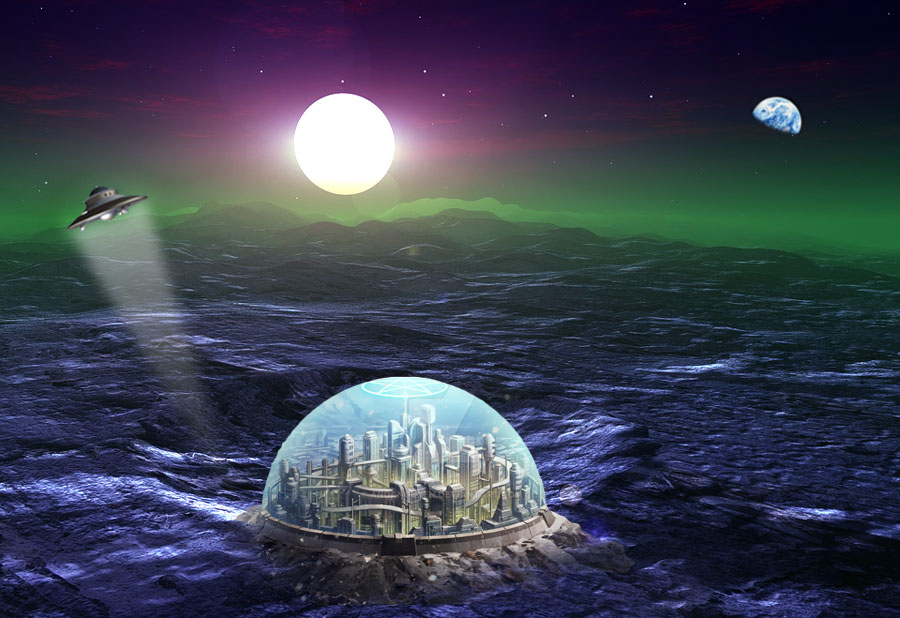 by William L. Brian II
by William L. Brian II
George Adamski wrote a book with Desmond Leslie in 1953 entitled Flying Saucers Have Landed. It deals with historical UFO sightings and Adamski’s initial experiences as a UFO contactee. Another book by Adamski in 1955, entitled Inside the Space Ships, covers his subsequent encounters with UFOs and their occupants. The following account was summarized from these two books.
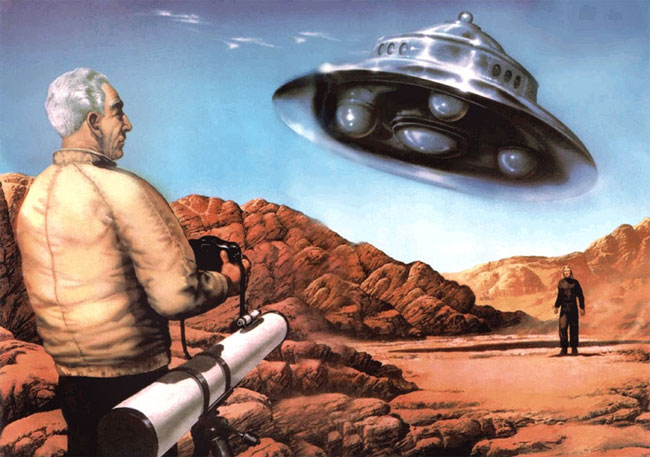 Adamski was an amateur astronomer living in Palomar Gardens, California. In 1946, he observed a gigantic spaceship hovering above a mountain ridge near his home. This
Adamski was an amateur astronomer living in Palomar Gardens, California. In 1946, he observed a gigantic spaceship hovering above a mountain ridge near his home. This 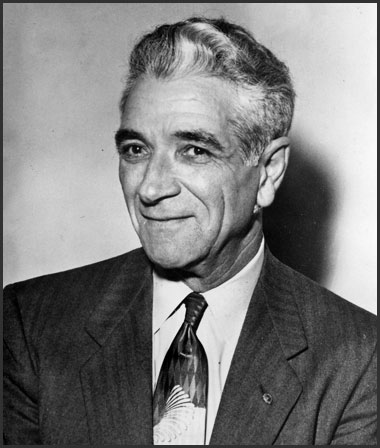 encouraged him to spend a considerable amount of time watching for them on a regular basis. In August 1947, he and four other observers counted 184 UFOs moving across the sky in about an hour’s time. As a result of the great number of sightings which had occurred in this period and Adamski’s reputation, some military people supposedly asked him if he would attempt to photograph them with his telescope. By 1951, he had successfully taken over 500 UFO photographs and became quite well-known for his work in the UFO field. Reports indicated that a number of saucers had been seen landing in the desert area to the east. In an effort to make closer contact, he made a number of trips to the desert in 1951 and 1952. It was on November 20, 1952, 10.2 miles from Desert Center, toward Parker, Arizona, that he first made contact with a spacecraft and its pilot.
encouraged him to spend a considerable amount of time watching for them on a regular basis. In August 1947, he and four other observers counted 184 UFOs moving across the sky in about an hour’s time. As a result of the great number of sightings which had occurred in this period and Adamski’s reputation, some military people supposedly asked him if he would attempt to photograph them with his telescope. By 1951, he had successfully taken over 500 UFO photographs and became quite well-known for his work in the UFO field. Reports indicated that a number of saucers had been seen landing in the desert area to the east. In an effort to make closer contact, he made a number of trips to the desert in 1951 and 1952. It was on November 20, 1952, 10.2 miles from Desert Center, toward Parker, Arizona, that he first made contact with a spacecraft and its pilot.
The craft landed and a man soon appeared, motioning Adamski to come over. In their conversation, the man indicated that one of their purposes for being here involved nuclear bombs and radioactive fallout.
Before sighting this smaller ship, Adamski and his three companions had seen a much larger, cylindrically-shaped craft. The space visitor indicated that the smaller ship came from the larger one. Adamski’s three companions were then some distance away, waiting for him to signal them when he finished. He had decided that if contact were to be made, it might be best if only one person were involved, so his friends waited behind. At this initial meeting, Adamski did not enter the ship, but was able to carefully observe it from the outside. In less than an hour after the sighting, the space visitor said that he had to leave and the craft took off. Adamski then signaled his companions and they made sketches and castings of the visitor’s strange footprints. They later reported the incident to the Phoenix Gazette.
On December 13, a small craft hovered above his house and he proceeded to take photographs of it. It approached within 100 feet and a film holder which Adamski had given to the man on the prior visit was dropped from one of the portholes. When the film was developed, one of the frames was replaced with a symbolic message.
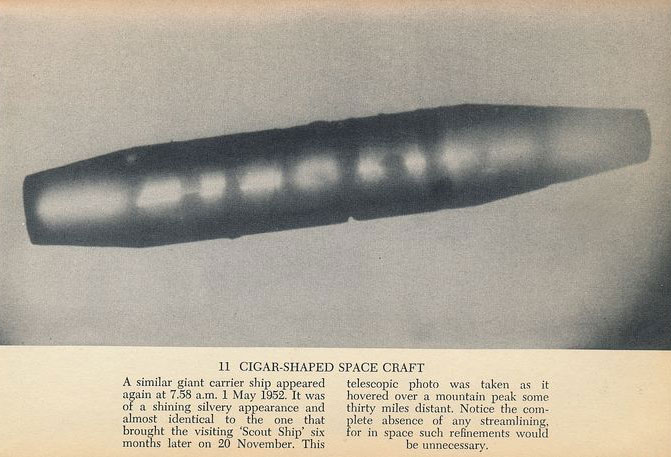 Adamski was later given a ride in a small craft to a mother ship which was hovering about 40,000 feet above the surface of the Earth. It was 150 feet in diameter and 2,000 feet long according to one of the crew. On board, he saw a picture of a larger ship which was several miles long, the equivalent of a traveling city. The mother ship then moved out to a position 50,000 miles from the Earth, and Adamski described what he saw through one of the portholes. He noted that the background of space was totally dark, yet it appeared that billions upon billions of fireflies were flickering everywhere. They were moving in all directions and were of many colors, like a gigantic celestial fireworks display.
Adamski was later given a ride in a small craft to a mother ship which was hovering about 40,000 feet above the surface of the Earth. It was 150 feet in diameter and 2,000 feet long according to one of the crew. On board, he saw a picture of a larger ship which was several miles long, the equivalent of a traveling city. The mother ship then moved out to a position 50,000 miles from the Earth, and Adamski described what he saw through one of the portholes. He noted that the background of space was totally dark, yet it appeared that billions upon billions of fireflies were flickering everywhere. They were moving in all directions and were of many colors, like a gigantic celestial fireworks display.
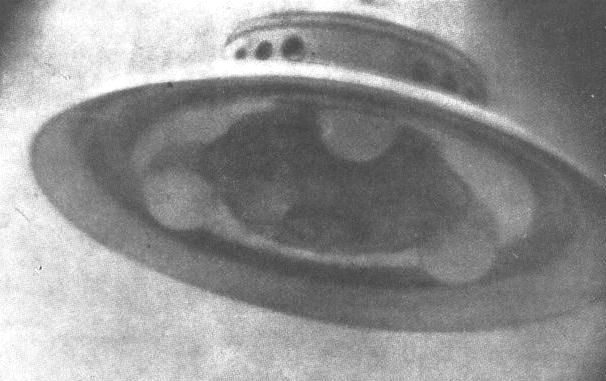 Two months later, Adamski was again contacted and taken to a different mother ship which was used as a laboratory for scientific analysis. These people explained to him that many of the smaller unmanned craft were used to collect data for their studies. Atmospheric samples were constantly collected and monitored for dangerous radioactive substances indicative of nuclear bomb testing. Adamski described one of the tests involving visual images of dust or space debris. He observed the constant swirling activity of tiny particles of matter on a screen. Fine matter would appear to condense into a solid body at times, and then disappear, reverting to a nearly invisible state. The formations would occasionally become so rarefied that they seemed to be transmuted into pure gases. With the formation of particle bodies, certain quantities of energy would take visible, solid form, and then immediately dissipate in an explosion or disintegration that was visible on the screen. Another group of instruments recorded the intensity and composition. The cycle of formation and disintegration was ceaseless, involving energy and matter reacting with other space particles. Adamski noted that when the energy gathered into a sheet-like formation or a cloud-like body, it disturbed everything near it in space. He believed that he was observing the force that permeated all space, and from which planets and galaxies are formed, as well as the force supporting and sustaining life and activity in the universe. The guide indicated that the same power propelled their ships through space.
Two months later, Adamski was again contacted and taken to a different mother ship which was used as a laboratory for scientific analysis. These people explained to him that many of the smaller unmanned craft were used to collect data for their studies. Atmospheric samples were constantly collected and monitored for dangerous radioactive substances indicative of nuclear bomb testing. Adamski described one of the tests involving visual images of dust or space debris. He observed the constant swirling activity of tiny particles of matter on a screen. Fine matter would appear to condense into a solid body at times, and then disappear, reverting to a nearly invisible state. The formations would occasionally become so rarefied that they seemed to be transmuted into pure gases. With the formation of particle bodies, certain quantities of energy would take visible, solid form, and then immediately dissipate in an explosion or disintegration that was visible on the screen. Another group of instruments recorded the intensity and composition. The cycle of formation and disintegration was ceaseless, involving energy and matter reacting with other space particles. Adamski noted that when the energy gathered into a sheet-like formation or a cloud-like body, it disturbed everything near it in space. He believed that he was observing the force that permeated all space, and from which planets and galaxies are formed, as well as the force supporting and sustaining life and activity in the universe. The guide indicated that the same power propelled their ships through space.
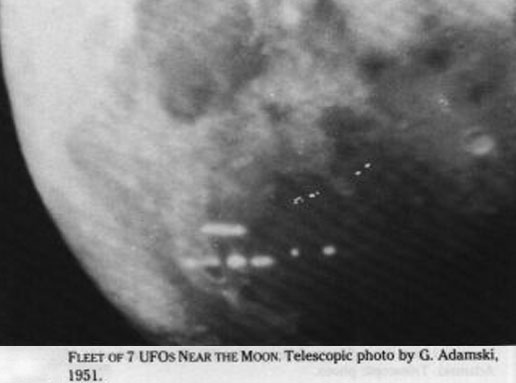 During this particular visit, the craft moved closer to the Moon and Adamski’s guide informed him that the Moon had air as indicated by their instruments. He told Adamski that air is not normally an obstruction to viewing another body as is claimed on Earth. He also mentioned the moving shadows of clouds which have been seen by Earth scientists on occasion. In addition, he said that the side of the Moon facing the Earth has clouds which are rarely heavy; however, the instruments indicated much heavier cloud activity, similar to Earth’s, in the temperate zone just beyond the rim. He compared the near lunar side to the Earth’s deserts, and mentioned that the temperature is not as hot as Earth scientists believe. He also stated that there is a strip of land around the center of the Moon which supports vegetation, trees, animals, and humans.
During this particular visit, the craft moved closer to the Moon and Adamski’s guide informed him that the Moon had air as indicated by their instruments. He told Adamski that air is not normally an obstruction to viewing another body as is claimed on Earth. He also mentioned the moving shadows of clouds which have been seen by Earth scientists on occasion. In addition, he said that the side of the Moon facing the Earth has clouds which are rarely heavy; however, the instruments indicated much heavier cloud activity, similar to Earth’s, in the temperate zone just beyond the rim. He compared the near lunar side to the Earth’s deserts, and mentioned that the temperature is not as hot as Earth scientists believe. He also stated that there is a strip of land around the center of the Moon which supports vegetation, trees, animals, and humans.
Adamski then described what he saw when looking through the ship’s telescopic instrument. He was amazed to discover how wrong Earth people were in their ideas about the Moon. Many of the craters turned out to be large valleys surrounded by mountains, and he stated that he could see definite indications that water must have existed on the near side at one time. His guide told him that there is still plenty of water on the opposite side and much hidden deep within the mountains on the near side. He also pointed out ancient waterlines on the flanks of mountains surrounding the craters and Adamski noticed deep ruts through the ground which must have been made by a heavy runoff of water. Adamski even saw vegetation and described the surface as fine and powdery, while other areas consisted of larger particles like coarse sand or fine gravel. As he watched, a small, four-legged, furry animal ran across the area he was observing.
When they reached the far side, the guide pointed out snow-covered mountains with heavy timber on the lower slopes. They also observed mountain lakes and rivers which emptied into a large body of water. A number of communities were seen in the valleys and on mountain slopes as well as a fair-sized city. His guide indicated that hangars (domes) were constructed near the cities for convenience in landing with supplies which are brought in to exchange for certain Moon minerals.
The reader is reminded that Adamski’s experiences occurred 15 years before men first landed on the Moon. Adamski’s incredible observations will be appraised after those of another contactee are presented.
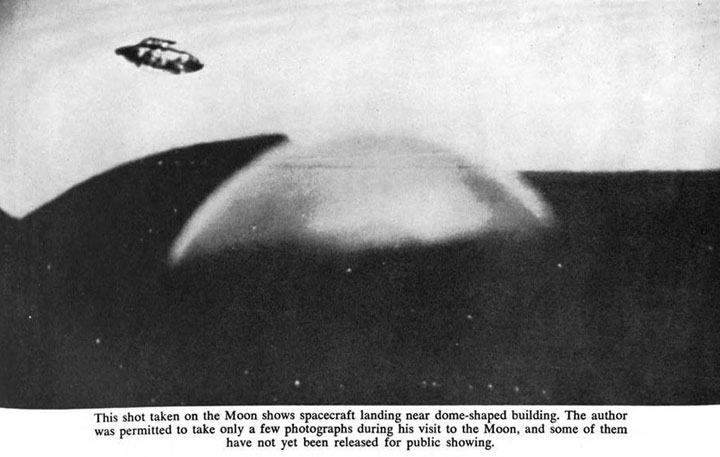
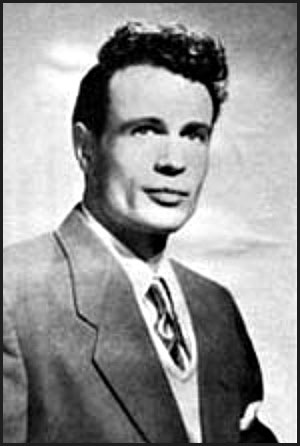 Howard Menger wrote From Outer Space to You in 1959. His experiences are just as shocking as Adamski’s. In August 1956, he was taken to the Moon and observed dome-shaped buildings and a craft making a landing near one. On the next trip in September, the ship actually landed and he was allowed to take certain pictures. Each of the three pictures appearing in his book shows a bright, illuminated, lunar sky. Two of the pictures show the white, hemispherical domes which have been referred to previously.
Howard Menger wrote From Outer Space to You in 1959. His experiences are just as shocking as Adamski’s. In August 1956, he was taken to the Moon and observed dome-shaped buildings and a craft making a landing near one. On the next trip in September, the ship actually landed and he was allowed to take certain pictures. Each of the three pictures appearing in his book shows a bright, illuminated, lunar sky. Two of the pictures show the white, hemispherical domes which have been referred to previously.
Menger described the dome-shaped building as 150 feet in diameter and 50 feet high, made of translucent material. The dome rested on a pedestal made of a solid white substance. After leaving the spaceship which had entered the dome, Menger and the other Earth visitors were led to a train-like vehicle with plastic domes over each coach. The vehicle had no wheels and was suspended about a foot above a copper highway. They were soon gliding noiselessly, visiting building after building. Other landmarks and points of interest were the mountains, valleys, and underground installations. In a section of the Moon near the far side, Menger saw terrain which reminded him of the Valley of Fire in Nevada. At that point, the guide permitted the visitors to stick their heads outside for a moment. The heat was like a blast furnace and Menger stated, “I was certain no one could have lived outside very long . . .”
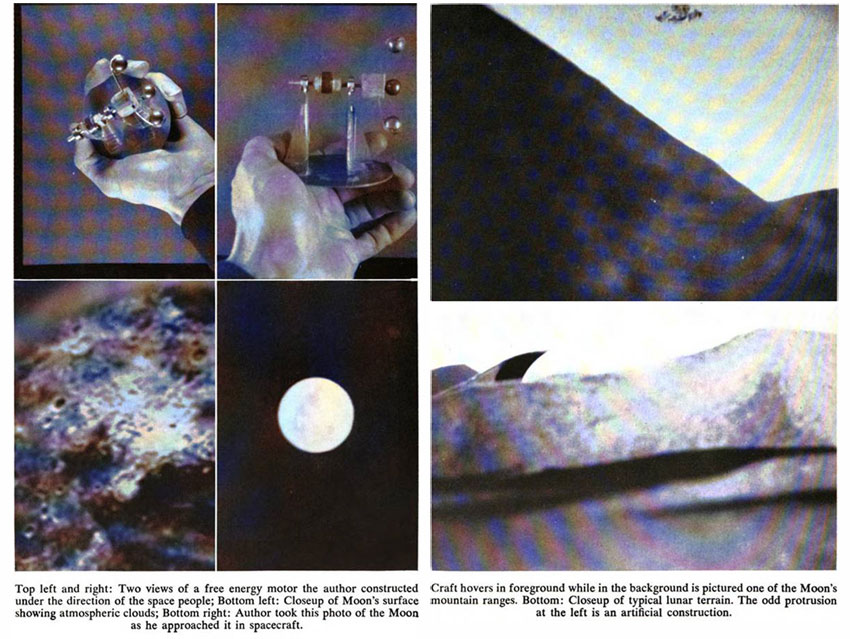 Menger observed wind funnels forming on the ground, drawing dust into tiny whirlwinds. The sky had a yellowish color and the mountains jutted into a saffron-colored sky. He described the ground as yellowish-white, powdery sand with stones, boulders, and minute plant life here and there. There were other visitors from Earth, including Russians, Japanese, and Germans.
Menger observed wind funnels forming on the ground, drawing dust into tiny whirlwinds. The sky had a yellowish color and the mountains jutted into a saffron-colored sky. He described the ground as yellowish-white, powdery sand with stones, boulders, and minute plant life here and there. There were other visitors from Earth, including Russians, Japanese, and Germans.
The experiences and observations of these UFO contactees will now be examined in light of the other evidence. On Adamski’s initial trip to the mother ship, he observed space through a porthole when they were 50,000 miles above the Earth. He noted that the background of space was totally dark. This implies that stars are not visible above the atmosphere with the naked eye.
Adamski also observed the firefly phenomenon and described it in the same manner as John Glenn did. How could Adamski have possibly discovered this in the early 1950’s if his story about the trip were not true? It is important to note that the “paint flake” explanation for the firefly effect in space is probably a NASA fabrication. UFOs would not use paint as a shield from space debris or heat. The intensity of the firefly effect observed by Adamski may have been much greater than any seen by the astronauts. This would be expected if he were looking at space through the intense energy field of the spaceship.
The guide then explained the nature of the ship’s propulsion source in terms that Adamski could understand. He stated that the ship’s energy was radiated into space for short distances at times, but up to several miles on other occasions. This explains why the astronauts would observe the firefly effect if they were closely followed or approached by UFOs. The UFO energy field would also account for the radio interference and other electronic glitches which occurred on some of the NASA space vehicles.
On his second space ride, Adamski observed space dust being activated by the same energy which powered the ship. These energy particles seem to carry a negative charge and may be comprised of photons of light. Since space dust has a slight overall positive charge, these negatively charged particles would be attracted to the dust. Adamski may have been observing these negative charges building up on space dust particles until an excess accumulated. At this point, the dust particles seemed to explode and disappear because the negatively charged energy particles rapidly disintegrated. The cycle would then repeat itself. Similar phenomena were noted to a lesser extent in the Earth’s atmosphere by the scientist Wilhelm Reich who called the particles orgone energy.
As the ship approached the Moon, the guide explained that the instruments were registering the Moon’s atmosphere. He also explained that air is not normally an obstruction in viewing another body. The space guide then described the shadows of clouds which had been seen by Earth astronomers in lunar valleys and craters. He explained that they are rarely dense, but that in the temperate zone can become more so. In addition, he claimed that the temperature extremes are not as high as that predicted by Earth scientists, and that a strip of habitable land exists with vegetation, trees, animals, and people.
Adamski then looked for himself and described things which seemingly could not have been known before the space program unless his trip actually took place. He observed ancient watermarks on mountains and craters which were later discovered by the Apollo astronauts. In addition, he described deep ruts in the ground and was convinced that only a heavy runoff of water in times past could have caused them. Further more, Adamski stated that some of the surface appeared fine and powdery while other areas consisted of coarse sand and fine gravel. This sounds like Neil Armstrong’s description of the lunar surface in the Sea of Tranquility. Adamski also saw sparse vegetation and a furry, four-legged animal running across his field of vision.
Here is a collection of dome type anomalies on the Moon from NASA:
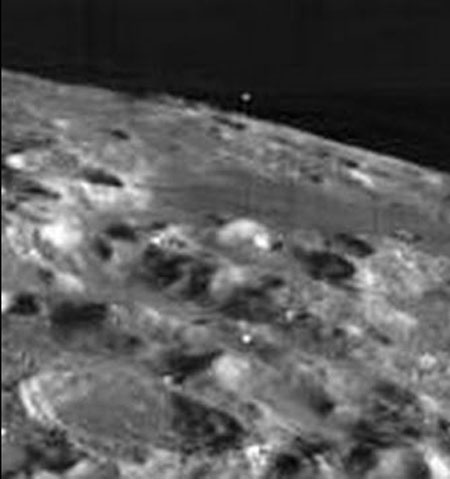
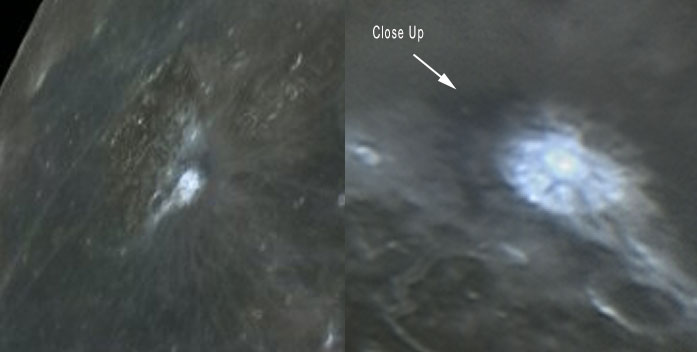
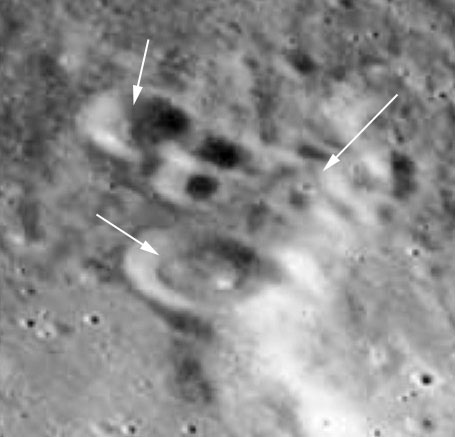
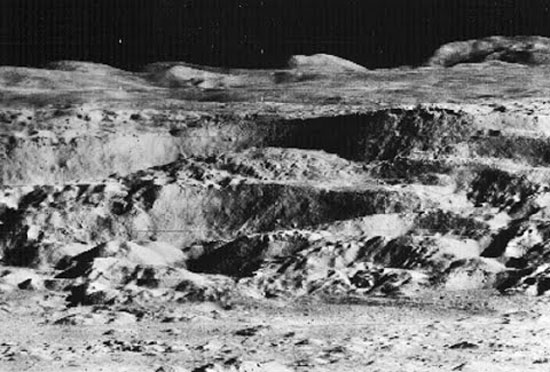
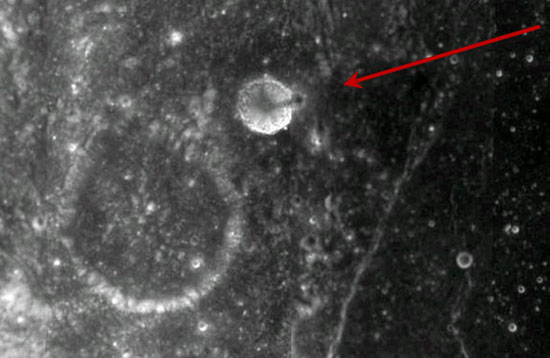 Howard Menger’s alleged experiences are just as revealing. His photographs and experiences suggest that the Moon has a breathable, dense atmosphere. The white, dome-shaped building he photographed was probably the same type of building which Adamski described as a hangar. He described a vehicle with no wheels suspended above a copper highway. The copper highway could be indicative of a type of antigravity based on electricity. Believe it or not, U.S. patents already exist which may account for the principle of operation of this lunar vehicle!
Howard Menger’s alleged experiences are just as revealing. His photographs and experiences suggest that the Moon has a breathable, dense atmosphere. The white, dome-shaped building he photographed was probably the same type of building which Adamski described as a hangar. He described a vehicle with no wheels suspended above a copper highway. The copper highway could be indicative of a type of antigravity based on electricity. Believe it or not, U.S. patents already exist which may account for the principle of operation of this lunar vehicle!
When Menger reached the terrain which reminded him of Nevada, he actually claimed to have breathed the lunar atmosphere. As expected, he held that the heat was extremely great, but the air pressure was evidently adequate to sustain life! He also observed wind, a yellow sky overhead, and a yellowish-orange sky near the horizon. The colors indicate that the atmosphere at that elevation might be deeper than the Earth’s. As light passes through more atmosphere, it shifts to longer wavelengths. The yellow sky overhead indicates a longer wavelength than the blue in Earth skies. Similarly, the orange hue above the mountains can be attributed to light which is shifted in wavelength still more as a result of the increased thickness of the atmosphere when looking through it toward the horizon. Menger’s description of the surface was similar to Adamski’s: a yellowish-white, powdery sand with stones and miniscule plant life.
There are still many unanswered questions, but this is to be expected. The subject matter presented has been suppressed to such an extent that the author could not readily walk down to the newsstand and read-all-about-it.
Excerpt from Moongate
Posted in Life On Other Worlds, Other Topics, UFOswith 1 comment.


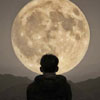
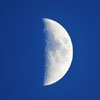
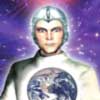
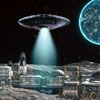
Amazing !!